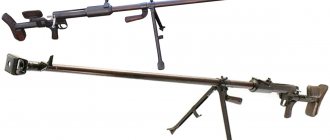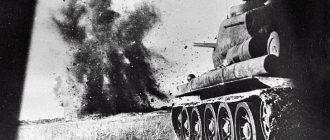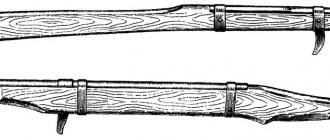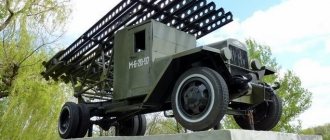At the beginning of July 1941, leading Soviet weapons designers received the task of urgently developing anti-tank rifles. Just 22 days later, Vasily Degtyarev presented to the state commission a single-shot anti-tank rifle, designed for a 14.5-mm cartridge with an armor-piercing incendiary bullet B-32 (steel core) or BS-41 (cermet core).
In parallel with Degtyarev, Sergei Simonov began developing an anti-tank rifle. The version of the self-loading anti-tank rifle he presented was so good that the Resolution of the State Defense Committee of August 29, 1941 contained a rather rare decision for a country at war: to adopt and put into production two variants of anti-tank rifles at once - the Simonov and Degtyarev systems.
- Type: Anti-tank rifle
- Designer: V. A. Degtyarev
- Country: USSR
Design features of PTRD-41
The gun, designated PTRD-41, was very simple in design, quite technologically advanced and cheap to manufacture. It was a system with manual loading of the cartridge and automatic opening of the bolt after the shot, which significantly increased the rate of fire and facilitated the process of removing spent cartridges.
Anti-tank rifle of the Simonov system - PTRS-41
Design
The design of the PTRD consisted of a bipod, a muzzle brake, a bolt with a spring, a handle and a butt-carriage. The recoil force is reduced by a muzzle brake, a butt pad and a spring in the butt-carriage. The mechanism of the gun is single-shot. The design has an interesting idea that increases the rate of fire of the gun and reduces the fatigue of the shooter. So, during recoil, a short stroke of the butt-carriage occurs and the bolt lever meets a special bracket that opens the bolt and extracts the cartridge case. The spent cartridge is thrown into the lower window. Charging occurs through the top window. A design flaw can be called the lack of store food, which was abandoned at the beginning of the war. The barrel had eight rifling to impart rotation to the bullet. For ease of carrying, a handle is provided. The PTRD had an opening sight on the left side with a full range of fire from 0-400 meters and 400-1000 meters. The sight on the left side did not provide left-handed people with the ability to fire the gun. A design flaw can be called the lack of magazine feed, which was abandoned at the beginning of the war, which would have made the PTR faster-firing. Even during the Second World War, there were attempts to install an optical sight on the PTRD, but attempts to install the sight were not implemented. During the military conflict in Ukraine in 2014-2017, various models of optical sights began to be successfully installed PTRDs According to available data, it is possible to shoot the PTRD at a distance of 2400 meters, at this distance it is possible to hit a passenger car. Shooting at a distance of over 1500 meters at armored personnel carriers/infantry fighting vehicles is useless.
Design and operating principle of PTRS-41
The anti-tank rifle of the Simonov system, which later received the PTRS-41 index, used the principle of automatic reloading when firing - removing part of the powder gases from the barrel and influencing them on the bolt through a gas piston with a rod - and had a magazine for five rounds. When creating his gun, Sergei Simonov made a simple and at the same time quite original decision: taking the design of his automatic 7.62 mm ABC-36 rifle as a basis, enlarge it to a 14.5 mm caliber.
Between the wars
The Germans' experience did not go unnoticed. Perhaps the most interesting example of the development of such weapons was the project of the English captain Boyce. The experience of the Spanish Civil War showed that despite the presence of artillery and machine guns of various types, infantry required light and less noticeable anti-tank weapons. And taking into account the fact that at that time powerful PTR cartridges still perfectly penetrated tanks with bulletproof armor, of which there were the majority, the conclusion was obvious.
PTR Boyce
Source: pinterest.ru
Boyce developed a gun, which he called the Elephant gun, but it went down in history under the name of the captain himself. Boyce abandoned the 12.7 mm cartridge for the Vickers machine gun and chose the most powerful 13.9 mm cartridge. The Boyce turned out to be quite successful: the top-mounted 5-round magazine and comfortable ergonomics were perfect for the shooter. But the armor penetration was not very good. It was necessary to shoot from 100 meters, otherwise the effect was sharply reduced.
Finnish Lahti, you can estimate the size
Source: pinterest.ru
Separately, we can note the use of “Boys” by the Finns during the Soviet-Finnish War. The Boyce tandem with their own Lahti anti-tank rifle at a monstrous 20 millimeters (often this gun could injure the shooter) performed well. The guns were used for shooting both at vehicles and at embrasures, fortifications, and were used as an anti-sniper option.
German PzB 39
Source: pinterest.ru
Research was also carried out in Poland. Their famous “secret” Ur gun (ostensibly for shipment to Uruguay) performed well in the fight against German light tanks and armored cars in 1939. And the Germans also had their own version of the PzB-38 “Panzerbühse”. Both guns eventually served in the Wehrmacht, but their caliber 7.92x108x94 left them no chance in the further course of the war.
Battle of Kursk: guns against tanks
During the most ambitious tank battle of the Great Patriotic War, which took place in the Kursk region in July 1943, combat crews armed with 14.5 mm anti-tank rifles of domestic design could often be found among the infantrymen. And this despite the fact that the bullets fired by these guns were capable of penetrating only 35 mm armor from a distance of 300 m. Probably, subsequently, German commanders had to be surprised more than once when they received the news that another PzKpfw V "Panther" or PzKpfw VI "Tiger" tank, having frontal armor of 100 and 110 mm, failed after a bullet fired from anti-tank rifle, damaged its chassis. The Ferdinands, whose frontal armor was 200 mm, became helpless because Soviet armor-piercing guns shot through the barrels of their guns.
A Soviet infantryman fires from a PTRD anti-tank rifle
Anti-tank rifles of the Red Army in production and at the front
Anti-tank rifles in the museum. In the foreground is the PTRD, behind it is the PTRS. Photo: Vitalykuzmin.net
Anti-tank rifles of two models became one of the main means of combating enemy armored vehicles for the Red Army during the Great Patriotic War. PTR designs by Degtyarev and Simonov were created in the shortest possible time and just a few months after the start of the war they found use on the battlefield. The constant development of enemy armored vehicles could limit the real potential of anti-tank rifles, but until the very end of the war such weapons and armor-piercing shooters were not left without work.
As soon as possible
The development of light anti-tank systems of the PTR type in various forms has been carried out in our country since the early thirties.
At different times, different models were adopted for service. However, in August 1940, all work stopped, and the existing products were removed from service. The command of the Red Army believed that thick-armored tanks protected from anti-tank gun fire would soon be in service with the potential enemy. Accordingly, the development of anti-tank defense was associated with artillery. The command's opinion changed on June 23, 1941. The next day after the start of the war, an order appeared to resume work on the PTR topic. The N.V. system gun was again sent to the training ground. Rukavishnikova. Leading enterprises received orders to develop new PTRs. Only a few weeks were given to complete the work.
14.5x114 mm cartridges in a pack for loading PTRS. Photo: Vitalykuzmin.net
New projects were created in the shortest possible time. Thus, KB-2 of the Kovrov Tool Plant No. 2 presented two anti-tank guns - from chief designer V.A. Degtyarev and from a group of engineers A.A. Dementieva. Based on the test results, the Dementyev PTR was seriously reworked, after which it received a recommendation for adoption.
At the same time, S.G. created his own PTR. Simonov. It differed from the previous model by the presence of automatic gas venting for independent recharging. Despite the great complexity, the project was prepared within the required time frame, and the PTR went to the test site to confirm the characteristics. The fine-tuning was associated with serious difficulties, but in the end it was possible to obtain the desired results.
On August 29, 1941, the Red Army adopted two new anti-tank rifles - the Degtyarev PTRD and the Simonov PTRS. Preparations for serial production have begun. The simpler PTRD began to be produced in September, and by the end of the year more than 17 thousand units were produced. The launch of the PTRS took a little longer, and the first production products rolled off the assembly line only in November. In the same November, anti-tank rifles of two types were used in battle for the first time.
The language of numbers
PTRD and PTRS were large-caliber rifles chambered for 14.5x114 mm, designed to destroy various types of protected targets. With their help it was proposed to hit tanks, firing points, incl. armored and aircraft. Depending on the type of target, fire was fired at distances of up to 500-800 m.
Armor-piercing guns with PTRD in position. Photo: Wikimedia Commons
Two PTRs used a 14.5x114 mm cartridge, originally created for the Rukavishnikov rifle mod. 1939. During the war, the main modifications of the cartridge were equipped with armor-piercing incendiary bullets B-32 (hardened steel core) and BS-41 (cermet core). A 30-g load of gunpowder ensured the acceleration of a bullet weighing 64 g to high speeds.
A characteristic feature of the PTR was the long barrel length, which made it possible to fully utilize the energy of the cartridge. PTRD and PTRS were equipped with rifled barrels 1350 mm long (93 klb). Due to this, the initial bullet speed reached 1020 m/s. The muzzle energy exceeded 33.2 kJ - several times higher than that of other small arms. The presence of a gas engine slightly reduced the energy of Simonov's PTR and affected its combat qualities.
Using the B-32 bullet, both anti-tank missiles from a distance of 100 m with a direct hit penetrated up to 40 mm of homogeneous armor. At a distance of 300 m, penetration for PTRD was reduced to 35 mm; Due to automation, PTRS could show less good results. With further increase in distance, penetration rates decreased. As noted in the shooting manual of 1942, shooting at armored vehicles could be carried out from 500 m, with the best results obtained at 300-400 m.
Evolution of goals
The abandonment of the PTR in 1940 was due to the fact that the Red Army command expected the enemy to have tanks with frontal armor at least 50-60 mm thick, which only artillery could deal with. As the events of the summer of 1941 showed, the enemy was simply overestimated. The main tanks of the Wehrmacht had much less powerful protection.
Degtyarev's gun and his crew in Stalingrad, August 1942. Photo by Pavel Troshkin (1909-1944) / Wikimedia Commons
The basis of the German tank fleet was light class vehicles. Thus, one of the most popular was the Pz.Kpfw.II tank - about 1,700 units of all modifications. Early versions of this vehicle had armor up to 13 (hull) and 15 mm (turret) thick. In later modifications, the maximum armor thickness reached 30-35 mm.
During the attack on the USSR, approx. 700 light tanks Pz.Kpfw.38(t) of Czechoslovak production. The hull and turret of such equipment had armor up to 25 mm thick, installed at different angles. Other areas were noticeably thinner.
Before the attack on the USSR, German industry managed to master the production of Pz.Kpfw.III medium tanks of a number of modifications. Early series vehicles had armor no thicker than 15 mm. Subsequently, the protection was increased to 30-50 mm, incl. using overhead parts.
Medium tanks Pz.Kpfw.IV initially had 30 mm frontal armor, but with further improvement, the protection was repeatedly improved. The latest modifications used a forehead with a thickness of 80 mm. However, even on the later Pz.Kpfw.IV the side projection had protection of no more than 30 mm.
Experiment: Simonov's gun with an optical sight. Photo: Armedman.ru
All subsequent German tanks, created after the attack on the USSR, had relatively thick armor in all projections. Its penetration from the anti-tank rifle at any range and angle was excluded.
Bullet vs armor
Thanks to the fairly high characteristics, PTRDs and PTRSs could hit Wehrmacht light tanks at distances of up to 300-500 m. Early medium tanks were also a good target that could be disabled with a successful hit.
However, later the situation began to change. Improved modifications and completely new tanks featured enhanced protection, both on the forehead and in other projections, which could protect them from anti-tank fire. Despite the strengthening of the frontal projection, the side often retained less thick armor, which did not go unnoticed by armor-piercing officers. Later tanks did not even penetrate the side - they responded with fire at the chassis, optics and weapons. The shooters still had a chance to hit the target from an acceptable distance.
It should be noted that realizing the full potential of the PTR was associated with special difficulties and required courage and sometimes heroism from the shooter. Unlike the tank crew, the PTR crew at the position had minimal protection. The effective range of fire did not exceed several hundred meters, which is why armor-piercing guns risked attracting the attention of tank crews or accompanying infantry. At the same time, such a tank-dangerous target became a priority for the enemy.
As a result, the successful fight against enemy tanks was accompanied by constant high losses among personnel. This fact is reflected in army folklore in the form of a saying about a long gun and a short life. However, in difficult conditions of 1941-42. there was no choice. Anti-tank rifles were a full-fledged element of infantry anti-tank weapons, working together with more powerful artillery.
German light tank Pz.Kpfw.II. Soviet anti-tank missiles penetrated his armor from any angle. Photo: Wikimedia Commons
In production and at the front
Serial production of PTRD started in September 1941, and within a few months the number of such products reached tens of thousands.
Production continued until 1944, and during this time the Red Army received more than 280 thousand guns. Simonov's PTR went into production a little later, and the complexity of the design affected the production rate. It was produced until 1945, transferring a total of 190 thousand products to the front. The anti-tank rifle was introduced into the formations in December 1941. Then the rifle regiment was given an anti-tank rifle company with three platoons of three sections each. The squad included three squads with guns. Subsequently, as the troops became saturated with weapons, it was possible to change personnel - up to the introduction of rifle companies into the battalion of the rifle regiment. Also, over time, an anti-tank rifle company appeared in the anti-tank division of the division.
Despite all the difficulties and risks, in the early stages of the war two types of anti-tank rifles were very effective weapons. It allowed rifle units to fight the vast majority of types of enemy armored vehicles, as well as hit other targets. Subsequently, the armor of enemy tanks improved, and by 1943-44. they ceased to be the main target of armor piercers. However, anti-tank rifles continued to be used to destroy light armored vehicles of various classes, firing points, etc. There are isolated cases of successful firing at low-flying aircraft.
Even having “lost” their original anti-tank purpose, Soviet anti-tank rifles were used en masse until the end of the war and successfully completed their assigned tasks. The last 14.5 mm bullets were fired on the streets of Berlin.
Medium Pz.Kpfw.IV Ausf. H. Thick frontal armor protects against anti-tank missiles, but the side plates had to be supplemented with screens. Photo of the Bundesarchiv
During the war years, serial anti-tank guns managed to prove themselves as effective, but difficult to use weapons. PTR crews have a combat record of hundreds and thousands of protected enemy vehicles, both temporarily disabled and out of combat, and completely destroyed. Thousands of armor-piercing soldiers received well-deserved military awards.
Contribution to victory
In general, the history of Soviet anti-tank rifles during the Great Patriotic War is of great interest.
Since the early thirties, our designers managed to thoroughly study the issue of light anti-tank systems and then lay the foundation for their further development. The development of the PTR direction was briefly interrupted, but already in the summer of 1941 all measures were taken to create and introduce new models. The results of these measures were not long in coming, and a simple and effective mass-produced anti-tank weapon appeared at the disposal of the Red Army rifle formations. PTRs became a successful addition to artillery and were used until the very end of the war. Moreover, their potential turned out to be much higher: Soviet anti-tank rifles are still used in local conflicts.
The goal is not only tanks
The high tactical and technical characteristics of anti-tank rifles made it possible to use them until the last days of the war. Armor-piercing crews easily dealt with enemy vehicles, low-flying aircraft, self-propelled guns and armored personnel carriers. In addition, anti-tank rifles were effectively used to fire at concrete fortifications (pillboxes) and guns.
Crew of the Soviet anti-tank rifle PTRD-41 in position during the Battle of Moscow. Moscow region, winter 1941-1942.










